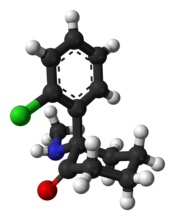「ケタミン」の版間の差分
ナビゲーションに移動
検索に移動
細編集の要約なし |
細編集の要約なし |
||
| 32行目: | 32行目: | ||
* [[Intravenous therapy|Intravenous]]: 100%<ref name="MathewZarate2016" /> | * [[Intravenous therapy|Intravenous]]: 100%<ref name="MathewZarate2016" /> | ||
* [[Intramuscular injection|Intramuscular]]: 93%<ref name="MathewZarate2016" /> | * [[Intramuscular injection|Intramuscular]]: 93%<ref name="MathewZarate2016" /> | ||
* [[Subcutaneous injection|Subcutaneous]]: high<ref name="Mao2016">'''Jianren Mao'''<br>Opioid-Induced Hyperalgesia <br>CRC Press | * [[Subcutaneous injection|Subcutaneous]]: high<ref name="Mao2016">'''Jianren Mao. (2016).'''<br>Opioid-Induced Hyperalgesia <br>CRC Press</ref> | ||
* [[Epidural administration|Epidural]]: 77%<ref name="Kintz2014">'''Pascal Kintz. (2014).'''<br>Toxicological Aspects of Drug-Facilitated Crimes<br>Elsevier Science</ref> | * [[Epidural administration|Epidural]]: 77%<ref name="Kintz2014">'''Pascal Kintz. (2014).'''<br>Toxicological Aspects of Drug-Facilitated Crimes<br>Elsevier Science</ref> | ||
* [[Intranasal administration|Intranasal]]: 8–50%<ref name="MathewZarate2016" /><ref name="pmid29736744"><pubmed> 29736744</pubmed></ref><ref name="sinner"><pubmed> 18175098 </pubmed></ref> | * [[Intranasal administration|Intranasal]]: 8–50%<ref name="MathewZarate2016" /><ref name="pmid29736744"><pubmed> 29736744</pubmed></ref><ref name="sinner"><pubmed> 18175098 </pubmed></ref> | ||
* [[Sublingual administration|Sublingual]]: 24–30%<ref name="MathewZarate2016" /><ref name="Hashimoto2019"><pubmed>31215725</pubmed></ref> | * [[Sublingual administration|Sublingual]]: 24–30%<ref name="MathewZarate2016" /><ref name="Hashimoto2019"><pubmed>31215725</pubmed></ref> | ||
* [[Rectal administration|Rectal]]: 11–30%<ref name="Nemeroff2017"> | * [[Rectal administration|Rectal]]: 11–30%<ref name="Nemeroff2017"> | ||
'''Alan F. Schatzberg | '''Alan F. Schatzberg & Charles B. Nemeroff. (2017).'''<br>The American Psychiatric Association Publishing Textbook of Psychopharmacology, Fifth Edition<br>American Psychiatric Pub, pp550-.</ref> | ||
<ref name=Zhang2018><pubmed> 30513009</pubmed> </ref> | <ref name=Zhang2018><pubmed> 30513009</pubmed> </ref> | ||
* [[Oral administration|By mouth]]: 16–29%<ref name="Kintz2014" /><ref name="DickmanSchneider2016">'''Andrew Dickman | * [[Oral administration|By mouth]]: 16–29%<ref name="Kintz2014" /><ref name="DickmanSchneider2016">'''Andrew Dickman & Jennifer Schneider. (2016).'''<br>The Syringe Driver: Continuous Subcutaneous Infusions in Palliative Care<br>Oxford University Press, pp. 114-</ref><ref name=Zhang2018 /> | ||
| protein_bound = 12–47% (low)<ref name="Kintz2014" /><ref name="sinner" /><ref name="DowdJohnson2016">'''Frank J. Dowd, Bart Johnson | | protein_bound = 12–47% (low)<ref name="Kintz2014" /><ref name="sinner" /><ref name="DowdJohnson2016">'''Frank J. Dowd, Bart Johnson & Angelo Mariotti. (2016).'''<br>Pharmacology and Therapeutics for Dentistry – E-Book<br>Elsevier Health Sciences, pp235–</ref> | ||
| metabolism = [[Liver]] ([[demethylation|''N''-demethylation]]):<ref name="MathewZarate2016" /><ref><pubmed>12065445</pubmed></ref> | | metabolism = [[Liver]] ([[demethylation|''N''-demethylation]]):<ref name="MathewZarate2016" /><ref><pubmed>12065445</pubmed></ref> | ||
* Major: [[CYP3A4]] | * Major: [[CYP3A4]] | ||
| 89行目: | 89行目: | ||
| ChEMBL_Ref = {{ebicite|correct|EBI}} | | ChEMBL_Ref = {{ebicite|correct|EBI}} | ||
| ChEMBL = 742 | | ChEMBL = 742 | ||
| synonyms = CI-581; CL-369; CM-52372-2<ref name="MortonHall2012">'''I. K. Morton, Judith M. Hall. (2012)'''<br>Concise Dictionary of Pharmacological Agents: Properties and Synonyms<br>Springer Science & Business Media, pp159–</ref> | | synonyms = CI-581; CL-369; CM-52372-2<ref name="MortonHall2012">'''I.K. Morton, & Judith M. Hall. (2012).'''<br>Concise Dictionary of Pharmacological Agents: Properties and Synonyms<br>Springer Science & Business Media, pp159–</ref> | ||
<!--Chemical data--> | <!--Chemical data--> | ||
2020年7月9日 (木) 22:36時点における版
- ↑
Bell, R.F., Eccleston, C., & Kalso, E.A. (2017).
Ketamine as an adjuvant to opioids for cancer pain. The Cochrane database of systematic reviews, 6, CD003351. [PubMed:28657160] [PMC] [WorldCat] [DOI] - ↑
Moyse, D.W., Kaye, A.D., Diaz, J.H., Qadri, M.Y., Lindsay, D., & Pyati, S. (2017).
Perioperative Ketamine Administration for Thoracotomy Pain. Pain physician, 20(3), 173-184. [PubMed:28339431] [WorldCat] - ↑ 3.0 3.1 3.2 3.3 3.4 3.5 3.6 3.7 3.8
Frohlich, J., & Van Horn, J.D. (2014).
Reviewing the ketamine model for schizophrenia. Journal of psychopharmacology (Oxford, England), 28(4), 287-302. [PubMed:24257811] [PMC] [WorldCat] [DOI] - ↑ Jianren Mao. (2016).
Opioid-Induced Hyperalgesia
CRC Press - ↑ 5.0 5.1 5.2 Pascal Kintz. (2014).
Toxicological Aspects of Drug-Facilitated Crimes
Elsevier Science - ↑
Molero, P., Ramos-Quiroga, J.A., Martin-Santos, R., Calvo-Sánchez, E., Gutiérrez-Rojas, L., & Meana, J.J. (2018).
Antidepressant Efficacy and Tolerability of Ketamine and Esketamine: A Critical Review. CNS drugs, 32(5), 411-420. [PubMed:29736744] [WorldCat] [DOI] - ↑ 7.0 7.1 7.2
Sinner, B., & Graf, B.M. (2008).
Ketamine. Handbook of experimental pharmacology, (182), 313-33. [PubMed:18175098] [WorldCat] [DOI] - ↑
Hashimoto, K. (2019).
Rapid-acting antidepressant ketamine, its metabolites and other candidates: A historical overview and future perspective. Psychiatry and clinical neurosciences, 73(10), 613-627. [PubMed:31215725] [PMC] [WorldCat] [DOI] - ↑
Alan F. Schatzberg & Charles B. Nemeroff. (2017).
The American Psychiatric Association Publishing Textbook of Psychopharmacology, Fifth Edition
American Psychiatric Pub, pp550-. - ↑ 10.0 10.1
Zhang, K., & Hashimoto, K. (2019).
An update on ketamine and its two enantiomers as rapid-acting antidepressants. Expert review of neurotherapeutics, 19(1), 83-92. [PubMed:30513009] [WorldCat] [DOI] - ↑ Andrew Dickman & Jennifer Schneider. (2016).
The Syringe Driver: Continuous Subcutaneous Infusions in Palliative Care
Oxford University Press, pp. 114- - ↑ Frank J. Dowd, Bart Johnson & Angelo Mariotti. (2016).
Pharmacology and Therapeutics for Dentistry – E-Book
Elsevier Health Sciences, pp235– - ↑
Hijazi, Y., & Boulieu, R. (2002).
Contribution of CYP3A4, CYP2B6, and CYP2C9 isoforms to N-demethylation of ketamine in human liver microsomes. Drug metabolism and disposition: the biological fate of chemicals, 30(7), 853-8. [PubMed:12065445] [WorldCat] [DOI] - ↑
Quibell, R., Prommer, E.E., Mihalyo, M., Twycross, R., & Wilcock, A. (2011).
Ketamine*. Journal of pain and symptom management, 41(3), 640-9. [PubMed:21419322] [WorldCat] [DOI] - ↑ I.K. Morton, & Judith M. Hall. (2012).
Concise Dictionary of Pharmacological Agents: Properties and Synonyms
Springer Science & Business Media, pp159–

